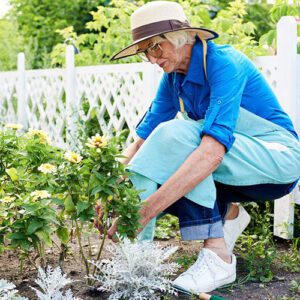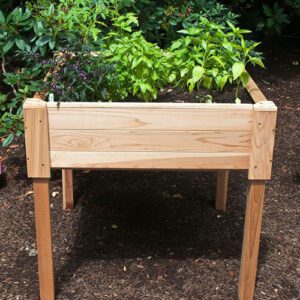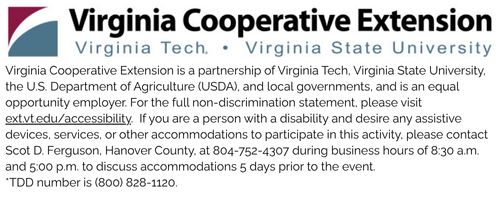As we age, many of us find ourselves seeking new hobbies that provide both enjoyment and purpose. Gardening is an excellent activity that can offer numerous benefits, including increased physical activity, improved mental health, and a sense of accomplishment. However, as we get older, gardening can become more challenging, requiring modifications and adaptations to ensure safety and comfort.
that can offer numerous benefits, including increased physical activity, improved mental health, and a sense of accomplishment. However, as we get older, gardening can become more challenging, requiring modifications and adaptations to ensure safety and comfort.
Let’s explore the importance of gardening as we age and find some tips for adapting your garden to your changing needs.
According to the University of Missouri Extension, gardening provides numerous physical benefits for older adults, including increased strength, flexibility, and cardiovascular health. Additionally, gardening can offer mental health benefits, such as reduced stress and improved cognitive function. Research has shown that gardening can also improve mood and increase feelings of happiness and well-being. Who couldn’t use more of that in our lives…
Despite the many benefits of gardening, it is essential to recognize that as we age, certain physical limitations may make traditional gardening techniques more challenging. For example, bending and kneeling can be difficult for older adults with arthritis or joint pain. Additionally, heavy lifting and long periods of standing can be taxing for those with mobility issues.
 Fortunately, there are many adaptations and modifications that can be made to a garden to ensure that it remains a safe and enjoyable activity for older adults. The University of Maryland Extension suggests raised garden beds as an excellent solution for those with mobility issues. Raised garden beds can be designed at a comfortable height, reducing the need for bending and kneeling. Additionally, they can be constructed with materials that are easy to grip, making it easier to move and manipulate plants and tools.
Fortunately, there are many adaptations and modifications that can be made to a garden to ensure that it remains a safe and enjoyable activity for older adults. The University of Maryland Extension suggests raised garden beds as an excellent solution for those with mobility issues. Raised garden beds can be designed at a comfortable height, reducing the need for bending and kneeling. Additionally, they can be constructed with materials that are easy to grip, making it easier to move and manipulate plants and tools.
Other modifications include using lightweight tools, such as those made from aluminum, to reduce strain on the joints. Additionally, installing pathways and handrails can make navigating the garden easier and safer. Lastly, it is important to consider the types of plants being grown.
Having the right tools for your specific needs is a way to work smarter, not harder. There are many wonderful options on the market for the “mature” gardener. Look for padded kneelers with handles that make it easier to get up and down or scooters that enable you to move around your garden more easily. Many tools have extended or wider handles that aid a stiff back or arthritic hands. Try fabric hoses that is lightweight and does not get kinked as you move around the garden to water. They are easy to coil back up to keep neat and tidy.
Choosing low-maintenance plants that require minimal pruning and watering can reduce the amount of physical labor required to maintain the garden. Perennials are an excellent choice because you can plant them once and enjoy them year-after-year. Native plants require less care and water because they are best adapted to your area. You might also select plants that will spread over time to fill in larger areas.
In conclusion, gardening can be an enjoyable and rewarding activity for older adults. It provides numerous physical and mental health benefits and can offer a sense of purpose and accomplishment. However, it is important to recognize that as we age, certain physical limitations may require modifications to the traditional gardening techniques. By making these modifications and resetting our expectations, we can ensure that gardening remains a safe and enjoyable activity for years to come.
This article is based on information published by several educational websites. The sources used include:
- University of Missouri Extension: “Gardening for Older Adults.” (https://extension.missouri.edu/publications/g7015)
- University of Maryland Extension: “Gardening for Seniors.” (https://extension.umd.edu/hgic/topics/gardening-seniors)
- University of California Agriculture and Natural Resources: “Gardening Tips for Seniors.” (https://ucanr.edu/sites/elderscape/Gardening_Tips_for_Seniors/)
These sources provided valuable insights into the benefits of gardening for older adults and offered practical tips for adapting gardens to meet the needs of seniors.

